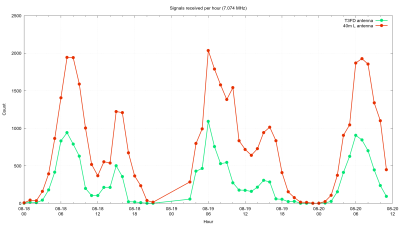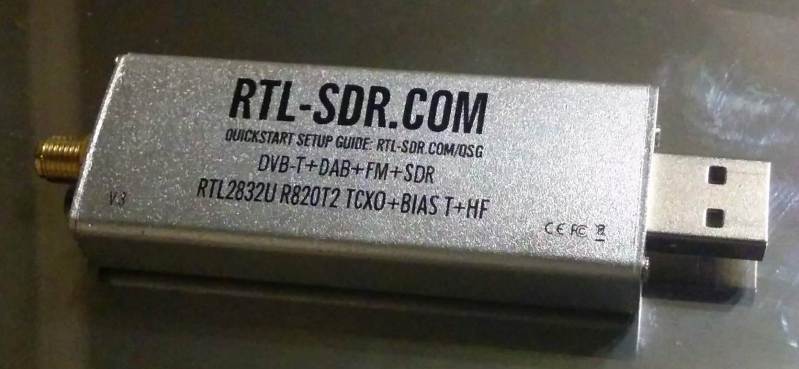Measuring the performance of antennas in absolute terms that can involve a lot of expensive equipment and specialized facilities. For practical applications, especially when building antennas, comparing performance in relative terms is more practical. Using cheap RTL-SDR dongles and Python, [Eric Urban] was able to compare the performance of two shortwave/HF antennas, and documented the entire process.
The two antennas in question was a single band inverted-L and smaller broadband T3FD antenna. [Eric] first gathered performance data for each over few days, connected to separate PCs with RTL-SDRs via low-pass filters. These were set up to receive FT8 transmissions, a popular digital ham radio mode, which allowed [Eric] to automate data collection completely. GQRX, a software receiver, converted the signals to audio, which was then piped into WSJT-X for demodulation.
 Data for each received FT8 transmission was recorded to a log file. [Eric] also modified GQRX and WSJT-X to give him all the remote control features he needed to automatically change frequencies. Between the two antenna setups, more than 100,000 FT8 transmissions were logged. Using the recorded data and Python he compared the number of received transmissions, the distance, and the heading to the transmitters, using the location information included in many FT8 transmissions. Where the same transmission was received by both antennas, the signal-to-noise ratios was compared.
Data for each received FT8 transmission was recorded to a log file. [Eric] also modified GQRX and WSJT-X to give him all the remote control features he needed to automatically change frequencies. Between the two antenna setups, more than 100,000 FT8 transmissions were logged. Using the recorded data and Python he compared the number of received transmissions, the distance, and the heading to the transmitters, using the location information included in many FT8 transmissions. Where the same transmission was received by both antennas, the signal-to-noise ratios was compared.
From all this data, [Eric] was able to learn that the inverted-L antenna performed better than the T3FD antenna on three of the four frequency bands that were tested. He also discovered that the inverted-L appeared to be “deaf” in one particular direction. Although the tests weren’t perfect, it is impressive how much practical data [Eric] was able to gather with low-cost hardware.
Some other DIY antennas we covered recently include a hybrid helical for using a geosynchronous ham radio repeater, an off-center dipole, and a directional antenna made from coat hangers. So go forth and attempt to tame the black magic of RF!
















I believe the correct name for the antenna is T2FD or TTFD (Terminated Transmission-line Foldd Dipole). Of course, the author might be attempting an accurate but subtle joke like renaming the antenna the Terrible T2FD.
Bill said: “I believe the correct name for the antenna is T2FD or TTFD (Terminated Transmission-line Foldd Dipole). Of course, the author might be attempting an accurate but subtle joke like renaming the antenna the Terrible T2FD.”
T3FD = Terminated 3-wire Folded Dipole, there is also T2FD = Terminated 2-wire Folded Dipole.
https://i.pinimg.com/originals/de/eb/88/deeb889b5cbdb3545738bc0157f0f672.png
Also called the radiating dummy load, excellent choice for a test because you know for sure it performs worse than any other commercial HF antenna on the market.
His method is basically ok because even antennas at the same location can behave different in real time due to fading that is different for each antenna.
I usually use a recorder and plot both field-strength curves on the same timescale.
If you use a wide filter and capture a lot of stations at the same time you can easily see the performance difference after applying the right time shift.
Even worse than the legendary G5RV?
Impressive!
The Inverted-L antenna is the most Underated antenna in Ham Radio. It performed flauously for me on 80M and 40M thru a Tuner while I was in Arizona. Need to do some SWL on my RTL-SDR. I have fun with it on AM & FM Broadcast bands.
AMHA you compare 2 antenna system they cant’ First tuned antenna Inv-L second wide band EWE antenna. No information about V to H for inv-L ratio and number of radials. High upper soil for T2FD. Probabely lot dB’s attenuation due H to V polarisation between antennas. F6IRA
The T2FD antenna can only be compared with a Dipole folded equally, at the same height and with the same inclination. -It’s not a panacea, but precisely everyone says that it works great on digital, because of its signal/noise ratio. I don’t think everyone is wrong…! But one more opinion is always good…! 73’s Enrique